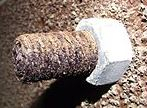Galvanic Corrosion
Galvanic Fastener Corrosion
Galvanic corrosion in fasteners occurs when dissimilar metals are in contact in water especially salt water. All metal fasteners have electrical potential when a natural electrical current flows from one metal to the other, one metal will begin corroding faster than the other. The result is that one fastener material will be eaten away much faster than the other. The use of dissimilar metals in structural design is common, particularly cases where the fastener material is different from the structure being joined. The electrolyte may be present in the form of rain, dew, snow, high humidity, ocean salt spray, or air pollution.
Through the correct material choice, galvanic corrosion can be eliminated or dramatically reduced, avoidance of dissimilar material combinations are the key. Engineers and designers must take into account the reactivity of the metals being joined and the metal used in the fasteners themselves.
.
All metals have some kind of electrical potential an indication is shown with the more active metals in Red, reducing activity moving to Orange then further reduced to Brown and then onto unreactive Blue.
.
Magnesium and Magnesium alloys; Zinc; Aluminium, Cadmium and Iron and Steel and cast iron .
Tin, 18-8 Mo stainless steel (active), 18-8 stainless steel (active), Chromium steel >11 % Cr (active), Nickel (active), Inconel, nickel-chromium alloy (active) and Hastelloy Alloy B.
Brasses (Cu-Zn alloys), Chromium steel >11 % Cr (passive), Inconel (passive), Copper, Bronzes (Cu-Sn alloys), Copper-nickel alloys, Monel (70Ni-30Cu), Nickel (passive), Inconel (80Ni-13Cr-7Fe), 304 Stainless Steel (passive) and 316 Stainless Steel (passive)
.
These alloys are cathodic and unreactive..
Hastelloy Alloy C (passive), Silver, Titanium, Gold and Platinum.
.
The various metals which are grouped together are reasonably compatible when used together; those in different groups may cause a corrosion problem. Some metals, especially those with significant contents of nickel and chromium are both active and passive.
Passive Fastener Metals
Metals on which an oxide film that prevents further attack on the metal is readily formed.
Active fastener Metals
Metals that react strongly or quickly with other substances.
Fastener assemblies should consider galvanic corrosion the nut, bolt and washer will touch different surfaces in the fastener assembly and what is being assembled
.
.
.
Galvanic Corrosion, Galvanic Fastener Corrosion, Fastener Corrosion, galvanic corrosion chart,




